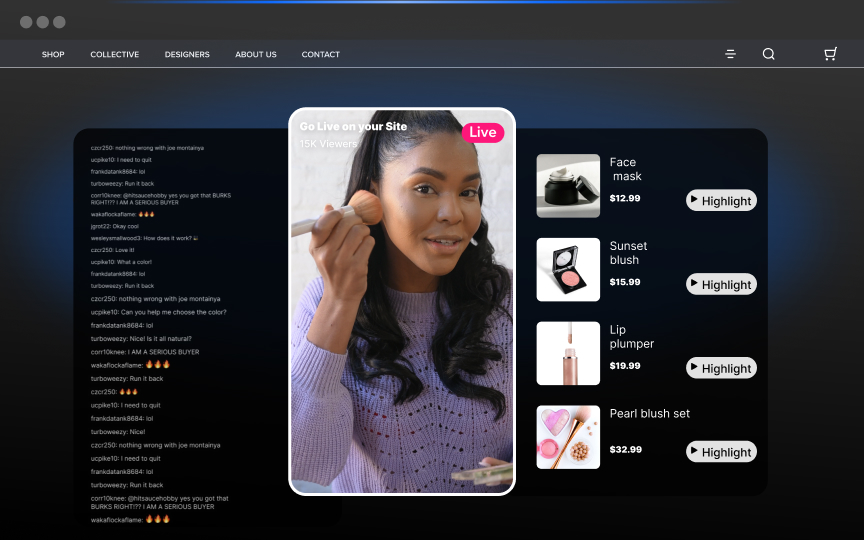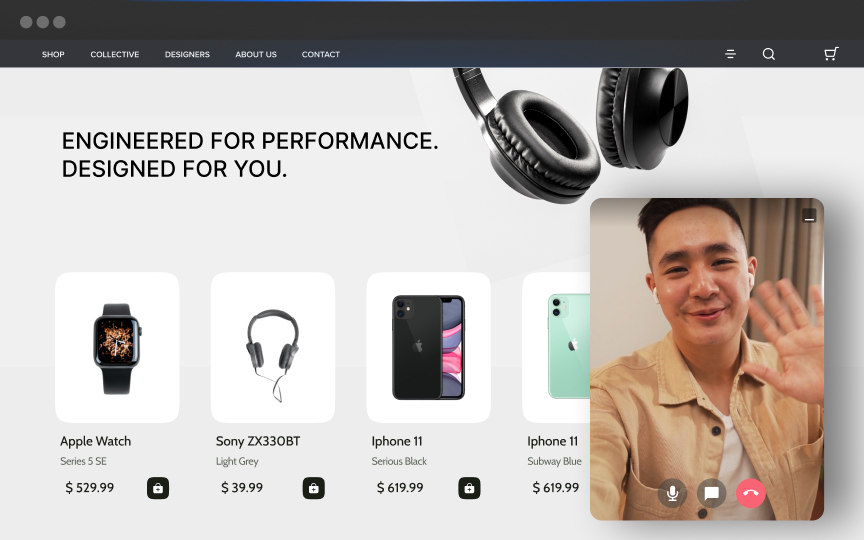How Retailers Use Immersive Shopping Experiences In Stores
Today's retailers are transforming stores using immersive shopping experiences that blend physical and digital elements. By incorporating technologies like augmented reality (AR), virtual reality (VR), and artificial intelligence (AI), they turn routine shopping into personalized adventures. This engagement creates emotional connections with brands, builds loyalty, and offers experiences that online-only retailers can't match.
The Evolution of Retail: From Transactional to Experiential
Retail has evolved dramatically from simply selling products to creating memorable customer journeys. This shift reflects changing shopper expectations and physical stores' need to compete in a digital world.
Several psychological mechanisms make immersive environments effective:
- Emotional Amplification: Multi-sensory experiences trigger stronger emotional responses than traditional shopping, creating deeper brand connections.
- Psychological Ownership: When shoppers interact with or customize products in immersive environments, they feel ownership before buying, strengthening their connection to the product.
- Reduction of Purchasing Uncertainty: AR and VR help solve a major hurdle in shopping by letting customers virtually try clothes, visualize furniture in their homes, or test products before purchase.
This shift toward experiential retail is driven by several factors:
- E-commerce Pressure: Physical stores must offer unique experiences that online shopping can't replicate.
- Changing Consumer Expectations: Younger shoppers want engaging, shareable retail experiences beyond simple transactions.
- Technological Advancements: AR, VR, and AI have become more accessible and affordable for retailers.
- Data-Driven Personalization: Advanced analytics enable highly personalized experiences tailored to individual preferences.
Research shows that immersive retail experiences can increase conversion rates by up to 17% and create lasting emotional connections that drive customer loyalty. Moreover, 71% of shoppers express willingness to visit stores more frequently if they offer AR experiences.
Core Technologies Powering Immersive Shopping Experiences
These core technologies are reshaping how customers interact with brands and products:
Augmented Reality (AR) Applications
AR helps shoppers see products in context. Furniture retailers show how pieces would look in your home before buying. This builds purchase confidence and reduces returns.
Beauty retailers let customers virtually try on makeup products, making shopping more interactive while gathering valuable data on customer preferences.
When setting up AR in stores, retailers need to consider:
- Space for AR stations
- Strong Wi-Fi infrastructure
- Connection to inventory systems
- Staff training to help customers
Shoppable video technology enhances these experiences by letting customers instantly purchase products they see in immersive demonstrations.
Virtual Reality (VR) Environments
VR creates complete brand worlds where customers explore products in ways impossible in traditional stores. Digital showrooms let customers experience products virtually when physical inventory is limited.
Beyond customer uses, VR helps with store planning and staff training, improving operational efficiency and customer service.
Interactive Displays and Smart Mirrors
Store surfaces become engagement points through interactive displays and smart mirrors. Smart mirrors in beauty and fashion retailers let customers virtually try products and get personalized recommendations.
Fashion stores have fitting rooms where customers request different sizes or colors without leaving. These technologies gather valuable information about customer preferences while making shopping more convenient.
Sensory Marketing and Environmental Design
Immersive retail engages all senses. Retailers create multi-sensory environments using scent, sound, lighting, and touch to make shopping memorable.
- Luxury retailers use specific scents to trigger emotions associated with their brand
- Fashion retailers carefully select music and lighting to match their brand identity
- Haptic feedback gives customers a sense of touch in virtual environments
These sensory elements influence emotions and buying decisions, creating engaging environments that online shopping can't match.
Data-Driven Personalization in Physical Spaces
Personalization is transforming in-store shopping. By using customer data strategically, retailers create tailored experiences that connect with individual shoppers.
Technologies Enabling Personalization
Several technologies make this personalization possible:
- AI assistants provide recommendations based on preferences and past purchases
- Facial recognition identifies returning customers for customized service
- Mobile apps connect online and offline shopping journeys
- RFID tags track inventory and customer interactions with products
Advanced video analytics can also track engagement with in-store displays and demonstrations, providing valuable insights into customer preferences.
Smart Mirrors: AI-Powered Upselling
Smart mirrors represent another clever use of personalization technology. These AI devices:
- Recognize face and body type
- Suggest matching items based on what you're trying on
- Let you virtually try on products before purchase
By offering personal recommendations, these mirrors create natural upselling opportunities while making shopping more helpful.
Privacy and Ethical Considerations
While personalization offers clear benefits, retailers must handle privacy concerns carefully:
- Transparency: Clearly explain how customer data is collected and used
- Opt-in Approaches: Give customers control over their data preferences
- Data Security: Protect customer information with strong security measures
By prioritizing trust and data protection, retailers can use personalization effectively while respecting customer privacy.
Bridging Digital and Physical: Omnichannel Immersion
Today's retailers are creating seamless experiences across all shopping channels, bringing digital technologies into physical spaces.
Live Streaming and Video Commerce in Retail Spaces
Physical stores are becoming broadcasting studios for product demos, using live streaming to reach wider audiences. Virtual stores with immersive content keep shoppers engaged up to 10 times longer than traditional online stores.
Firework's shoppable video platform allows retailers to create engaging live shopping experiences that connect physical stores with online audiences.
Setting up effective live streaming requires:
- Quality equipment: Good cameras, lighting, and audio
- Staff training: Helping employees get comfortable on camera
- Content planning: Creating engaging demonstrations and scripts
By turning stores into content hubs, retailers reach more people and create engaging experiences for both in-store and online shoppers.
Social Media Integration in Physical Retail
Creating Instagram-worthy spots in stores has become a smart retail strategy. These social media-friendly experiences make in-store shopping more fun while extending reach beyond physical limitations.
To measure ROI on these social-friendly designs, retailers track:
- Social media mentions
- Hashtag usage related to store experiences
- Engagement metrics (likes, shares, comments)
Mobile App Extensions of In-Store Experiences
Mobile apps improve navigation, provide product information, and enable quick checkout in physical stores. When creating companion apps, retailers should ensure they:
- Enhance rather than distract from the physical experience
- Show real-time inventory information
- Offer personal recommendations based on in-store behavior
- Make product information easily accessible
Firework's AVA virtual assistant can integrate with mobile apps to provide personalized recommendations and answer customer questions, creating a more seamless shopping experience.
Sector-Specific Applications and Case Studies
Different retail sectors are using immersive technologies in unique ways to transform their spaces and connect with customers.
Luxury Retail Immersion
Luxury brands excel at creating exclusive immersive experiences that reflect their premium products. They use mixed reality to blend digital stories with physical displays, taking visitors on journeys through brand history and craftsmanship.
Interactive displays create Instagram-worthy moments that extend beyond store walls, increasing visibility and encouraging social sharing.
Fast Fashion's Experiential Approach
Fast fashion retailers create high-energy environments that still feel personal, using technology to enhance shopping at scale. Leading retailers integrate AR for real-time customization and virtual try-ons with impressive results—20% higher purchase rates and 15% larger basket sizes.
Rolling out these technologies across multiple locations presents challenges in maintaining consistent experiences. Retailers address this by developing central content management systems and investing in network infrastructure.
Grocery and Essential Retail Innovation
Even everyday shopping is becoming more engaging through immersive elements. Grocery stores use AR to show additional product information on shelves, helping customers make better choices.
Some supermarkets have AR-enabled apps that let shoppers scan products for nutritional information, recipe ideas, or complementary products. This adds value to shopping while educating consumers about their purchases.
Home and Furniture Retail Solutions
The home and furniture sector quickly adopted immersive technologies to solve visualization challenges. AR apps let customers see furniture in their homes before buying, significantly reducing returns by enabling more informed decisions.
Industry analysts estimate AR visualization tools can reduce return rates by up to 25% in furniture retail. This saves money while boosting customer purchase confidence.
Measuring Success: Metrics and ROI for Immersive Retail
Evaluating immersive retail initiatives requires looking beyond traditional sales figures. Here are the key performance indicators retailers use:
Sales Performance
The most direct success measure is sales lift. Virtual stores powered by immersive content have reported an impressive 88% sales boost compared to traditional e-commerce platforms.
Customer Engagement
Immersive retail experiences keep customers around longer. Virtual stores see up to 10 times longer session durations compared to traditional e-commerce platforms. This extended engagement gives more opportunities for brand storytelling and product discovery.
Customer Satisfaction and Loyalty
Net Promoter Score (NPS) measures customer satisfaction with immersive experiences. Retailers should also track return rates, as technologies like virtual try-ons can significantly reduce product returns.
Operational Efficiency
Immersive retail can lower acquisition costs by personalizing marketing and improving product targeting. Fewer returns also contribute to operational savings.
Brand Awareness and Loyalty
Tracking social media mentions, hashtag usage, and user-generated content related to immersive experiences provides insights into brand awareness and customer loyalty.
Key Considerations for Measurement
- Establish Clear Baseline Metrics: Before implementing immersive experiences, set benchmarks to accurately measure impact.
- Use A/B Testing: Compare immersive and traditional retail format performance to understand effectiveness.
- Collect Customer Feedback: Analyze feedback to continuously improve immersive offerings.
- Leverage Data for Strategy: Use data collected through immersive experiences to inform future product development and marketing strategies.
Implementation Roadmap for Retailers
Integrating immersive technologies into retail stores requires a strategic approach. Here's a practical framework:
Assessment
Start by evaluating your current store setup and identifying opportunities for immersive experiences. This assessment helps determine which technologies best fit your brand and customer needs.
Planning
Develop a comprehensive plan including:
- Budgeting: Allocate resources for hardware, software, content creation, and maintenance.
- Technology Selection: Choose AR, VR, or other immersive technologies that match your goals.
- Timeline: Create a phased implementation schedule to manage resources effectively.
Execution
Implement your plan in stages:
- Pilot Program: Start with a pilot in select stores to test and refine the experience.
- Staff Training: Train employees thoroughly on new technologies and customer interaction approaches.
- Rollout: Gradually expand successful implementations to more locations.
Evaluation
Create feedback loops to continuously improve your immersive retail experiences:
- Data Analysis: Collect and analyze customer feedback and usage data.
- Monitor Metrics: Track key metrics like engagement rates, sales lift, and customer satisfaction scores.
- Iterate: Regularly assess whether updates or expansions to your immersive offerings are needed.
Addressing Common Challenges
Retailers often face several hurdles when implementing immersive technologies:
- High Implementation Costs: Consider partnerships with tech providers or explore ready-made platforms to reduce initial investments.
- Technical Complexity: Partner with specialized providers like Firework to overcome technical hurdles.
- Scalability Issues: Implement centralized management systems for consistent experiences across locations.
- Consumer Adoption Barriers: Run marketing campaigns highlighting the fun and convenience of immersive experiences. Offer clear instructions and staff assistance in-store.
- Content Creation Challenges: Collaborate with creative agencies and use AI for personalized content generation to keep experiences fresh.
- Network Infrastructure Requirements: Invest in edge computing and robust connectivity for seamless AR/VR experiences.
- Privacy and Security Concerns: Implement strong data protection measures and educate customers about data usage policies.
Future Trends in Immersive Retail
The future of immersive retail promises even more exciting developments that will transform shopping experiences:
5G Enabling Seamless AR/VR Experiences
5G networks will supercharge immersive retail technologies with ultra-low latency and high-speed connectivity. This means retailers can offer better immersive experiences without needing expensive on-site hardware.
AI and Predictive Experiences
AI will personalize immersive retail experiences in remarkable ways. By analyzing customer data, AI can anticipate preferences, creating tailored shopping journeys for each person. Firework's 2025 retail playbook explores how these technologies will evolve over the coming years.
Blockchain for Transparent Product Storytelling
Blockchain will change how brands share product origins and authenticity. In immersive retail settings, blockchain can let customers trace a product's journey through interactive AR displays, building trust and satisfying demand for ethical products.
The Metaverse and Physical Retail Intersection
The metaverse meeting physical retail could create entirely new ways to shop. Virtual stores might connect seamlessly with physical locations, letting customers move effortlessly between digital and physical shopping.
By 2030, stores are expected to fully integrate mixed reality with physical retail spaces. This integration will blur the lines between online and offline shopping, creating unified brand experiences across all channels.
Haptic Feedback and Multi-Sensory Engagement
Advances in haptic technology will add a new dimension to immersive retail. Customers will be able to "feel" products virtually, adding touch to digital interactions. This multi-sensory engagement will especially impact industries like fashion and electronics.
Creating Lasting Impressions in Physical Retail
Immersive retail is changing how customers connect with brands and products in physical stores. Using technologies like AR, VR, and AI, retailers of all sizes can create memorable moments that build loyalty and drive sales.
Success comes from balancing technological innovation with human connection. The best implementations seamlessly blend digital elements with personal service and authentic brand storytelling.
Small retailers with tight budgets can start with simple AR experiences or interactive displays. Larger brands can push boundaries with complete VR environments or AI personalization. Regardless of size, focus on improving the customer journey and solving real problems.
Immersive retail isn't about technology for its own sake. It's about creating emotional connections that stay with customers long after they leave the store. By crafting experiences that surprise, delight, and add real value, physical stores can thrive in an increasingly digital world.
Ready to Transform Your Retail Experience?
Don't get left behind in the retail revolution. Firework's immersive video commerce platform can help you create engaging, memorable shopping experiences that drive sales and build customer loyalty.
Take the first step today: Download our 2025 Fashion & Apparel Video Commerce Playbook to discover how leading retailers are using immersive technologies to create the stores of tomorrow.
Or contact our team to schedule a personalized demo and see how Firework can bring your retail vision to life.
Unlock Exclusive Insights
By submitting this form, you agree to Firework's privacy policy and consent to receive personalized marketing communications. You can unsubscribe at any time.






























